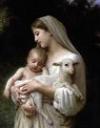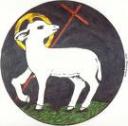Its fleece was white as snow.
And everywhere that Mary went,
The Lamb was sure to go.
In Aleister Crowley’ Book 4, in the Interlude after chapter VII of part II, the author(s) present a mind-bender:
‘Every nursery rime contains profound magical secrets which are open to everyone who has made a study of the correspondences of the Holy Qabalah. To puzzle out an imaginary meaning for this “nonsense” sets one thinking of the Mysteries; one enters into deep contemplation of holy things and God Himself leads the soul to a real illumination. Hence also the necessity of Incarnation: the soul must descend into all falsity in order to attain All-Truth’.
And proceed to analyze Old Mother Hubbard; Little Bo Peep; Little Miss Muffet; Little Jack Horner; Tom, Tom the Piper’s Son; Hickery, Dickery Dock; Humpty Dumpty; Peter, Peter, pumpkin eater; Taffy was a Welshman; By, Baby Bunting!; and Pat-a-cake, pat-a-cake, baker’s man.
In a similar frame of mind let us look at Mary and her lamb.
Mary had a little Lamb:
‘Mary’ is the standard Anglicization from the Latin name ‘Maria’ which was given to all female members in the Marius clan, ‘Marius’ in turn being derived from Mars, the Roman god of war, and as such an iconic name for a major Roman family.
One of the major sleights of mind in Bible exegesis is the conflation of the Latin ‘Maria’ with the Hebrew ‘Miriam’ which is a completely different name. However note that ‘Miriam’ is sometimes written ‘Mariam’, and in Latin ‘Mariam’ is ‘Maria’ in the accusative (object) case. This happenstance or coincidence is a little joke of Eris or maybe of Azathoth.
There is no Maria character in the early gospels. She is unknown in Paul, in the Gospel of Thomas and in the Gospel of Peter. Nor does she appear in Q. The Gospel of John, of which the first draft may be earlier than that of Mark, has a mother of Jesus, but she is resolutely anonymous. There is no indication at all that she is called ‘Maria’, and indeed why would a Jewish woman have a Latin name? The author of Mark, be he whoever, seems to be the creator of the Maria character.
In Josephus there are several Miriams, mainly from the Maccabean family. In fact two of the Maccabean Miriams became wives of Herod, called the Great. On the other hand, there is only one Maria in Josephus (War of the Jews VI, iii), who is a woman caught in the siege of Jerusalem who is starving because the rapacious militia take all the food. She solves this by roasting and eating her own suckling son. She is described as of the House of Hyssop, and hyssop is the plant that Moses said that the Israelites should use when marking their house with the blood of the sacrificed Passover lamb. (Exodus 12:7). Roasting is also the method specified for the Passover sacrifice (Exodus 12:9). Hence War, VI, iii would seem to imply that Mary had a little lamb, whether ‘had’ means ‘was with’ or whether it means that she ate it.
Why a lamb? In addition to the Jewish tradition of the Passover lamb, there is an interesting pun: The Aramaic word ‘imera’ means ‘lamb’; the Hebrew word ‘imerah’ means ‘word’ or ‘logos’. Thus we get an equivocation that cuts directly to the heart of Christianity.
Also. A lamb was symbolic of the age of Aries which was ending in the first century CE, the time when the Jesus stories are set.
Its fleece was white as snow.
This would seem to be a reference to Mark, 9.3 where as part of the Transfiguration, Jesus’ clothes become intensely brilliantly white.
There are precedents for this in the Jewish Bible:
In Daniel 7.9 the Ancient of Days has clothing as white as snow.
Psalm 51.7 ‘wash me and I will be whiter than white’.
The practice had continued in Judeo-Islam, and white is the prescribed colour of clothing for the Hajj.
Part of the conflation of Maria with Miriam reappears here. The prototype Miriam, the sister of Moses, is sometimes referred to as ‘Snow-White Miriam’, a reference to Numbers, 12 where Miriam and Aaron speak up against Moses for his arrogance and his exogamous marriage, and Miriam is struck with ‘tzaraat’ (often mistranslated as ‘leprosy’), turning her ‘white as snow’. This story is found only in the Elohist strand of the Torah, that is the traditions of the priests of Shiloh, of Israel and Samaria, not of Judea.
And everywhere that Mary went,
Maria is a representative of the Marius clan, which in turn represents the Roman empire. Thus she stands metonymously for the Empire which stretches from Mesopotamia to Britain.
The Lamb was sure to go.Christianity would inevitably stretch all across the Empire and beyond.
………………………
Crowley adds a warning. “If it is thought to be a joke, the reader is one useless kind of fool; if it is thought that …. The makers of the rimes had any occult intention, he is another kind of useless fool”.
It is of course claimed that the rime, Mary had a little Lamb, was composed by one John Roulstone about a Mary Sawyer who took her lamb to school in Sterling, Massachusetts in 1830. Of course it is also claimed that the first telling of a resurrected messiah, son of a virgin, was by somebody called Mark around 70 CE. But we know that there were earlier resurrected messiahs, also sons of virgins.
References:
John M. Allegro. The Dead Sea Scrolls and the Christian Myth. p174.
Joe Atwill. Caesar’s Messiah. p 45-8.